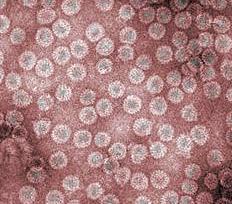At TheHealthBoard, we're committed to delivering accurate, trustworthy information. Our expert-authored content is rigorously fact-checked and sourced from credible authorities. Discover how we uphold the highest standards in providing you with reliable knowledge.
What is HIV?
Human Immunodeficiency Virus (HIV) is a retrovirus which attacks the T-cells in the immune system. If allowed to run unchecked through the body, HIV infection typically leads to Acquired Immune Deficiency Syndrome (AIDS), a condition which is fatal without treatment. The virus was first identified in the 1980s, and it was known by a number of alternate names including human T-lymphotropic virus-III (HTLV-III), lymphadenopathy-associated virus (LAV), and AIDS-associated retrovirus (ARV). As of 2008, there is no cure for this infection.
Infection with HIV occurs as a result of contact with bodily fluids like blood, semen, vaginal secretions, and breast milk. Saliva does not appear to carry the virus, although if there are wounds inside the mouth, it can be present the saliva. Once HIV enters the body, the retrovirus hijacks T-cells, forcing them to produce replications of it and transporting the virus throughout the body. Like other retroviruses, HIV carries its genetic material in RNA, rather than DNA.

By hijacking the T-cells, HIV makes these cells unavailable to the immune system. As a result, the virus weakens the immune system, putting the patient at risk of developing an opportunistic infection. If a patient infected with the virus develops an opportunistic infection, he or she is diagnosed with Acquired Immune Deficiency Syndrome. The difference between HIV and AIDS is that HIV is a virus, while AIDS is a collection of infections and symptoms caused by the infection.

The risk of infection with HIV can be greatly reduced or prevented by being careful in situations where body fluids may be exchanged. Using barrier protection during sexual contact is highly recommended, as is wearing gloves in settings where blood may be present, such as a car accident.
A blood test can be used to check for the presence of HIV in the body. Many doctors use cheek swabs for testing, in a technique which is less invasive than a blood test. Regular testing is strongly recommended, so that the virus can be caught early. With the use of certain drugs, expression of HIV in the body can be inhibited, slowing or preventing the development of AIDS. In around 1% of cases, an infection fails to develop into AIDS. Patients who fall into this small category are known as non-progressors.

Some people are infected with HIV without being aware of it. An infection can cause symptoms like a runny nose, headaches, coughing, or nausea, or the virus may cause no symptoms at all. Unless regular testing is used to check for the virus, HIV may not be diagnosed until after opportunistic infections have set in, causing AIDS. Several conditions are hallmarks of AIDS, including Kaposi's Sarcoma, pneumocystis pneumonia, night sweats, cytomegalovirus, and toxoplasmosis. These conditions primarily strike people with compromised immune systems, such as cancer patients and the elderly, and when they appear in someone who is otherwise healthy, they usually indicate the presence of an HIV infection.
AS FEATURED ON:
AS FEATURED ON:














Discussion Comments
At present, there is no recognized standard for establishing the presence or absence of antibodies to HIV-1 or HIV-2 in human blood.
I have worked in the HIV/AIDS field for almost 13 years as a social worker in a non-profit social service agency. Today I will be giving a talk at a local university to a cast preparing to present the musical "Rent". I was reading about the musical to get a little more background and eventually came to this site. I am very impressed with the clear, informative and "non-preachy" discussion of HIV/AIDS that is presented here. Thank you.
Post your comments